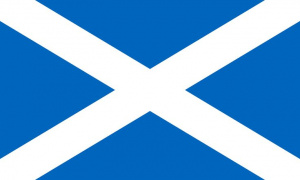Language/Scottish-gaelic/Grammar/Noun-Gender-and-Plurals
| ◀️ Definite and Indefinite Articles — Previous Lesson | Next Lesson — Common Household Items ▶️ |
Welcome to our lesson on Noun Gender and Plurals in Scottish Gaelic! Understanding how nouns function in this beautiful language is crucial, as it lays the foundation for your journey in mastering Gaelic. Noun gender and pluralization may seem daunting at first, but with patience and practice, you'll soon find it becomes second nature.
In this lesson, we will explore the following:
Importance of Noun Gender in Scottish Gaelic[edit | edit source]
Noun gender is a fundamental aspect of Scottish Gaelic grammar. Unlike English, where nouns do not have gender, Gaelic nouns are categorized as either masculine or feminine. This distinction is essential not only for understanding the nouns themselves but also for using the correct articles, adjectives, and verb forms that agree with them.
Understanding noun gender helps you:
- Master the use of definite and indefinite articles.
- Formulate sentences accurately.
- Enhance your overall comprehension and fluency in Gaelic.
Noun Gender Overview[edit | edit source]
In Scottish Gaelic, every noun is assigned a gender. Here are some important points to keep in mind:
Masculine Nouns[edit | edit source]
Masculine nouns often refer to male beings or can be objects and concepts traditionally associated with masculinity. Common endings for masculine nouns include:
-an (e.g., bòthar* - road)
-air (e.g., cailleach* - old woman)
Feminine Nouns[edit | edit source]
Feminine nouns typically refer to female beings or objects and concepts traditionally associated with femininity. Common endings for feminine nouns include:
-achd (e.g., sgoil* - school)
-e (e.g., màthair* - mother)
Identifying Noun Gender[edit | edit source]
While there are rules and common endings that can guide you, there are many exceptions in Gaelic. Here are some strategies to help identify noun gender:
- Look at the noun’s ending: This is often a good initial indicator.
- Familiarize yourself with common nouns: Start with essential vocabulary and practice identifying their gender.
- Use memory aids: Associating nouns with images or stories can help reinforce their genders.
Forming Plurals in Scottish Gaelic[edit | edit source]
Once you've grasped the concept of noun gender, the next step is learning how to form plurals. Pluralization in Scottish Gaelic can be quite diverse and does not follow a single rule. Here are the main ways to form plurals:
Common Pluralization Patterns[edit | edit source]
1. Adding -an: For many masculine nouns.
2. Adding -a: For many feminine nouns.
3. Changing the vowel: In some cases, nouns undergo a vowel change.
4. Using irregular forms: Some nouns have unique plural forms that you will need to memorize.
Examples of Noun Gender and Plurals[edit | edit source]
Let's look at some examples to illustrate these concepts.
Masculine Noun Examples[edit | edit source]
| Scottish Gaelic | Pronunciation | English |
|---|---|---|
| gille | /ˈɡɪlʲə/ | boy |
| cat | /kat/ | cat |
| sagart | /ˈsaɡəɾt/ | priest |
| leabhar | /ˈlʲau̯əɾ/ | book |
| bòthar | /ˈpɔːhər/ | road |
Feminine Noun Examples[edit | edit source]
| Scottish Gaelic | Pronunciation | English |
|---|---|---|
| cailleach | /ˈkaːlʲəx/ | old woman |
| màthair | /ˈmɑːhɪr/ | mother |
| sgoil | /sɡɔilʲ/ | school |
| tìr | /tʲiːr/ | land |
| nighean | /ˈniːən/ | daughter |
Forming Plurals Examples[edit | edit source]
Now, let's see how these nouns change when we put them in plural form.
Masculine Plurals[edit | edit source]
| Scottish Gaelic | Pronunciation | English |
|---|---|---|
| gillean | /ˈɡɪlʲən/ | boys |
| catan | /ˈkat̪ən/ | cats |
| sagartan | /ˈsaɡəɾt̪ən/ | priests |
| leabhraichean | /ˈlʲau̯əɾɪxən/ | books |
| bòtharan | /ˈpɔːhərən/ | roads |
Feminine Plurals[edit | edit source]
| Scottish Gaelic | Pronunciation | English |
|---|---|---|
| cailleachan | /ˈkaːlʲəxən/ | old women |
| màthairean | /ˈmɑːhɪrən/ | mothers |
| sgoiltean | /sɡɔilʲt̪ən/ | schools |
| tìrean | /tʲiːrən/ | lands |
| nighean | /ˈniːən/ | daughters |
Practice Exercise: Identifying Noun Gender[edit | edit source]
Now it’s time for you to practice identifying the gender of nouns!
1. Identify the gender of the following nouns:
tighinn* (coming)
faoileag* (seagull)
còmhlan* (band)
pàirt* (part)
Solutions:
1. tighinn - Masculine
2. faoileag - Feminine
3. còmhlan - Masculine
4. pàirt - Feminine
Practice Exercise: Forming Plurals[edit | edit source]
Complete the following tasks by forming the plural of each noun.
1. gille
2. màthair
3. leabhar
4. sgoil
5. cat
Solutions:
1. gillean (boys)
2. màthairean (mothers)
3. leabhraichean (books)
4. sgoiltean (schools)
5. catan (cats)
Recap and Further Practice[edit | edit source]
In this lesson, we explored the concept of noun gender and how to form plurals in Scottish Gaelic. Remember, consistent practice is key to mastering these concepts. Here are some additional exercises you can try:
Exercise 1: Create a list of 10 nouns (5 masculine and 5 feminine) and practice identifying their genders.
Exercise 2: Choose 5 new nouns and form their plurals.
Exercise 3: Write 5 sentences using nouns in both their singular and plural forms to demonstrate your understanding.
Conclusion[edit | edit source]
You've made it through the basics of noun gender and pluralization in Scottish Gaelic! It's a lot to digest, but with practice, you'll become more comfortable with these structures. Remember to refer back to this lesson whenever you feel uncertain.
As you continue your journey in learning Scottish Gaelic, keep your enthusiasm high! The more you engage with the language, the more intuitive these grammatical concepts will become.
Other Lessons[edit | edit source]
- How to Use Have
- Using Adverbs
- Future Tense
- 0 to A1 Course
- Personal Pronouns
- Describing with Adjectives
- Conditional Mood
- Questions
- Negation
- Using Prepositions
| ◀️ Definite and Indefinite Articles — Previous Lesson | Next Lesson — Common Household Items ▶️ |

